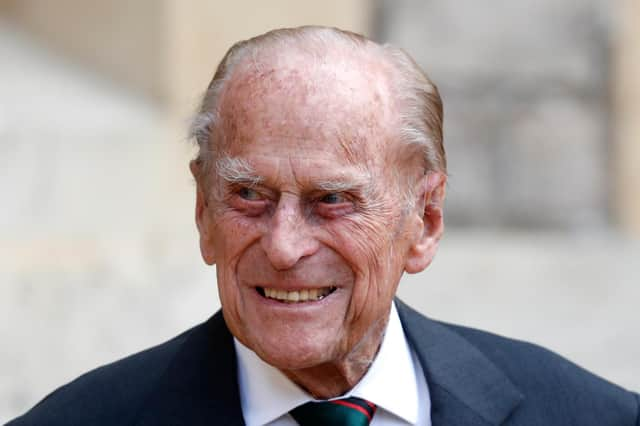Who will be Duke of Edinburgh next? Why did Prince Philip hold the title, what does it mean - and who will succeed him


The Duke of Edinburgh has died aged 99, Buckingham Palace has announced.
A statement from the Palace said: "It is with deep sorrow that Her Majesty The Queen has announced the death of her beloved husband, His Royal Highness The Prince Philip, Duke of Edinburgh.
Advertisement
Hide AdAdvertisement
Hide Ad"His Royal Highness passed away peacefully this morning at Windsor Castle."
Prince Philip was married to Queen Elizabeth II for more than seven decades and was the longest-serving consort in British history.
The duke held his title since his marriage to the Queen.
But why was Philip made Duke of Edinburgh, what is the significance of the title - and who will succeed him?
Here is everything you need to know.
Why was Prince Philip made the Duke of Edinburgh?
Before Prince Philip was married, he renounced his Greek and Danish royal titles, giving up his place in the line of succession to the Greek throne.
Advertisement
Hide AdAdvertisement
Hide AdHe was naturalised as a British citizen and took the anglicised version of his mother's maiden name, Mountbatten, as his surname.
On his wedding day on 20 November 1947, Philip was given the title of Duke of Edinburgh by his father-in-law King George VI.
After Queen Elizabeth II ascended the throne, she made the decision in 1957 to make Philip a prince of the UK, in addition to his dukedom.
What does the Duke of Edinburgh title mean?
The Duke of Edinburgh was a patron, president or member of over 780 organisations.
Advertisement
Hide AdAdvertisement
Hide AdHe was the longest-serving consort of a reigning British monarch, while also being the oldest ever male member of the royal family, with his 100th birthday approaching in 2021.
Prince Philip also served as chairman of The Duke of Edinburgh’s Award, the world’s leading youth achievement award.
The Duke of Edinburgh title is named after the city of Edinburgh.
It is a substantive title that has been created three different times for members of the royal family.
Advertisement
Hide AdAdvertisement
Hide AdThe first time the title was created was in 1726, when King George I bestowed it on his grandson Prince Frederick.
Following that, Queen Victoria created the title again in 1866 for her second son Prince Alfred.
Traditionally, Alfred was to be the Duke of York - the usual title of the second son of the reigning monarch.
The Duke of Edinburgh title was created for a third time for Philip Mountbatten when he married Princess Elizabeth.
Advertisement
Hide AdAdvertisement
Hide AdElizabeth was styled Duchess of Edinburgh until she ascended the throne in 1952.
Who will succeed him?
As Philip is not in the royal line of succession, the order will not change following his death.
Prince Charles is still first in line to the throne, followed by Prince William and then his three children.
As the Duke of Edinburgh title is a lifelong peerage, it will now pass on.
Advertisement
Hide AdAdvertisement
Hide AdPhilip’s youngest son, Prince Edward, 56, is expected to inherit the title.
Edward currently holds an earldom, a lower-ranking peerage than his brothers who both received dukedoms from the Queen on their wedding days.
Becoming the Duke of Edinburgh will mean Edward has to take on his father’s legacy and continue his work with the DofE award scheme.
What is the Duke of Edinburgh’s Award?
The Duke of Edinburgh’s Award was first launched in 1956, in collaboration with German educationalist Kurt Hahn and Lord Hunt, who led the first successful climb of Everest.
It has now expanded to operate in more than 140 countries.
Advertisement
Hide AdAdvertisement
Hide AdYoung people aged between 14 and 24 sign up to the Award for extra-curricular experiences and to learn new outdoor and life skills.
The Bronze, Silver and Gold Awards are a recognised mark of achievement by employers.
Typically, young people will complete tasks which involve helping the community and the environment, developing some new skills and planning, training for and completing an outdoor expedition.
What other titles did Prince Philip have?
As well as the title of Duke of Edinburgh, Prince Philip was bestowed with the titles Earl of Merioneth and Baron Greenwich when he married Queen Elizabeth.
Advertisement
Hide AdAdvertisement
Hide AdWhile the palace referred to him simply as The Duke of Edinburgh, Philip’s full title was a mouthful at 133 words long.
His list of titles and honours had been added to throughout the years. Some were earned, some were gifted and some were a combination of the two.
The Duke of Edinburgh’s full title was: “His Royal Highness The Prince Philip, Duke of Edinburgh, Earl of Merioneth, Baron Greenwich, Royal Knight of the Most Noble Order of the Garter, Extra Knight of the Most Ancient and Most Noble Order of the Thistle, Member of the Order of Merit, Grand Master and First and Principal Knight Grand Cross of the Most Excellent Order of the British Empire, Knight of the Order of Australia, Additional Member of the Order of New Zealand, Extra Companion of the Queen’s Service Order, Royal Chief of the Order of Logohu, Extraordinary Companion of the Order of Canada, Extraordinary Commander of the Order of Military Merit, Lord of Her Majesty’s Most Honourable Privy Council, Privy Councillor of the Queen’s Privy Council for Canada, Personal Aide-de-Camp to Her Majesty, Lord High Admiral of the United Kingdom.”
Philip was also granted knighthoods from many of the world’s nations, including Greece, Denmark, Ethiopia and Brazil.
His title of Lord High Admiral, a gift from the Queen on his 90th birthday, made him the titular head of the Royal Navy.